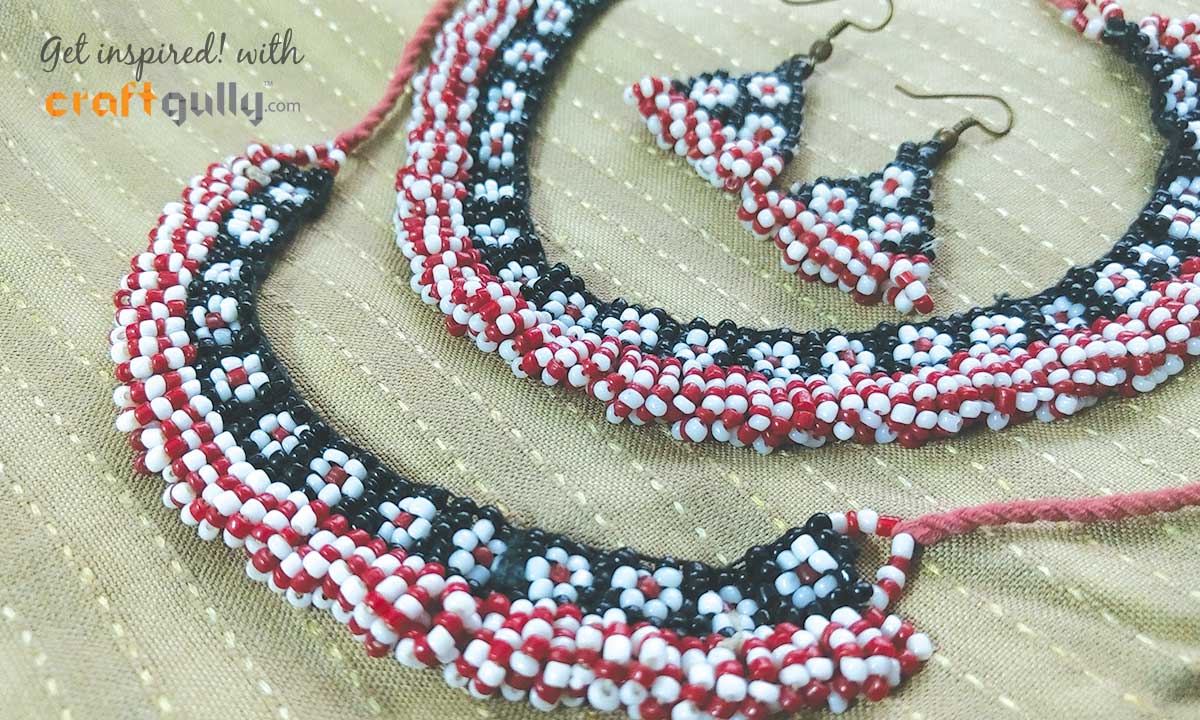Indian Beaded Jewellery and Accessories

A mere mention of ‘beads’ makes us think of the cheerful-looking pieces of jewellery in a store of a local market or perhaps, the stunning pieces of jewellery worn by the royalties. However, beads are also commonly used in crafting beautiful wearable, decorative and traditional accessories in different regions of India. Interestingly, these beaded jewellery and accessories have been linked to several regional traditions since ages.
We discovered some amazing beaded items crafted and commonly used in different regions of Gujarat. The state is well-known for its bead work, also known as Moti Bharat (bead embroidery), which is given the form of items known as Indhonis (base for pots), Mangal Kalash (Kalash used for pujas), Naariyal (coconut), Toran (door or wall hangings) and more.

These items are painstakingly made by using either bead crochet, bead stringing or bead braiding techniques. The art form originates from the regions of North Gujarat – Saurashtra and Kutchh. Beaded jewellery items from South Gujarat are also popular, as they are made by the tribals residing in the region.
The gypsies of Rajasthan, namely the Kalbelia and the Bopas, are known for their music, dance and bold and colourful attire. One of the most striking things about their get-up is their popping bright beaded jewellery. The Kalbelia women commonly wear panels of strung beads in rectangle or other shapes on their clothes or around their waists. They also wear colourful head gear that marks their identity. Whereas, the Bopa women wear different types of jewellery at the same time and beads are integral to what they wear.

Another community from Rajasthan – Marwaris celebrate the festival of Rakshabandhan with brothers as well as sisters-in-law. Known for their love for bejewelled items, the Rakhis and Lumbas, which they use for their brothers and sisters-in-laws respectively, are often made with beads.
Most religions in India use beaded strings (commonly referred to as ‘malas’) or bracelets for prayers and it is amazing to see the different types of beads used for crafting them. Malas used by the Buddhists are often made from seed beads of the Bodhi tree or semi-precious beads.
The string of beads used by the Muslims or Persians is often called Misbaha or Tasbih. These are crafted using wooden beads, olive seeds or pearls and sometimes even beads made from ivory, amber or plastic. Hindu ‘japmalas’ are often made of sandalwood beads, tulsi beads or the holy Rudraksh (a type of bead).
The use of fancy beads and pearls is now common for creating hair accessories, Maang Teeka (traditionally worn by Hindu brides), (traditional accessory for Muslim brides), beaded brooches and as embellishments for ‘Pagdis’ for grooms. Some of these are made using real pearls or semi-precious beads. Punjabi beaded ‘Juttis’ – a type of footwear inspired by the Pakistani Khussa Jutti, is also traditionally worn by grooms in North India.
Pearl nose rings form a quintessential accessories for the brides from Maharashtra. Better known as ‘naths’, these nose rings are mostly pearls set in a floral design and embellished with a single coloured bead. Bridal jewellery in India has now come to include antique designs with a modern twist. Items like haathphool (worn in Rajasthan), Vanki (used in the South) and Paizeb (worn by brides from Hyderabad) are now made with mixed materials, including pearls or coloured beads.
Genuine pearls were believed to ward off misfortune and hence, were popular with the royalty. Pearl necklaces and other accessories are found in abundance in the Southern region. The medieval period in India saw the kings and those related to them wear several items made of pearls. Women in the region often wear pearl necklaces with gold pendants, which are either amulets or figures of deities.
Southern India is also known for its exquisite temple jewellery; both ancient and modern designs often used genuine pearls alongside other gems. Likewise, temples in the other regions too use beaded jewellery for adorning the idols.
If this is how modern India has taken to beaded accessories and jewellery, there is the tribal folk of India that still wears them as a part of their regular attire.
The Naga tribe in the North East wear vibrant jewellery and accessories and their love for colours and design is evident in the way they create them. They use a range of beads, right from cowries to seeds, and shells to konyak, cornelium and glass beads. While men wear beaded belts, neckpieces, cuffs and chest cross bands, the women folk wear huge neckpieces, earrings, conch jewellery for adorning their backs and often medallions as well.
Tribal beaded jewellery worn by the Bondo women from Orissa is as authentic as it gets. Their attire includes a short skirt and beautiful, chunky jewellery on top. They wear huge breast plates made of strands of glass seed beads and sometimes even headpieces, made with wound beaded pieces. The tribes of Himachal too are known to use beads. The Gaddis are known for their caps, adorned with feathers, beads and dried flowers.
Down South, there is the Hallakki tribe in Karnataka; they wear strings of beads around their necks, which hang till the stomach. The indigenous tribe of Andamans – Jarawas are also found wearing simple, yet attractive beaded accessories. They mainly wear a combination of neckpieces made with a string of beads and sometimes even those made with cowries or shells.
Do you own any of the items we have mentioned in the article or better still, have tried making them? Leave a comment for us and our crafters.



Leave a Comment